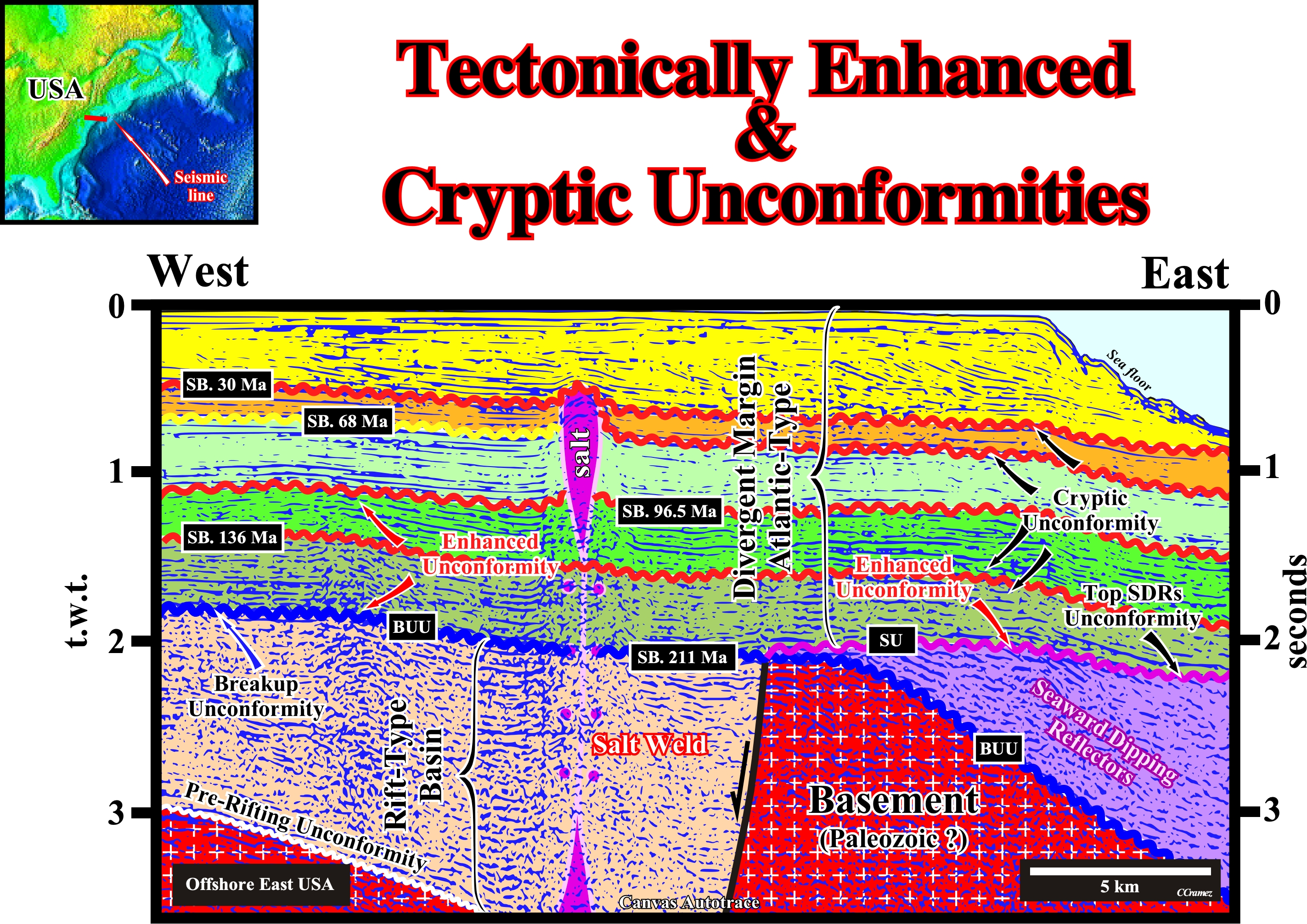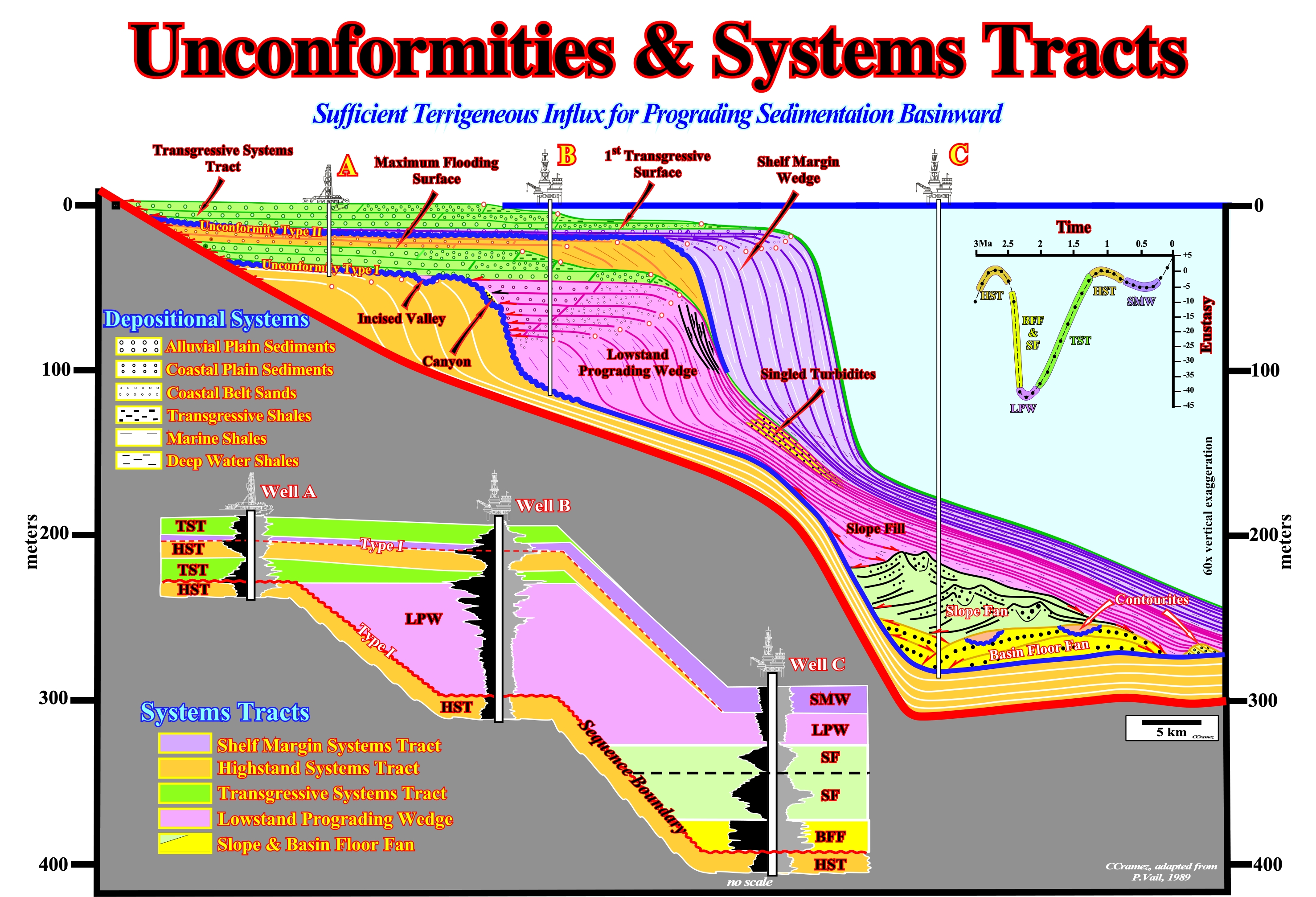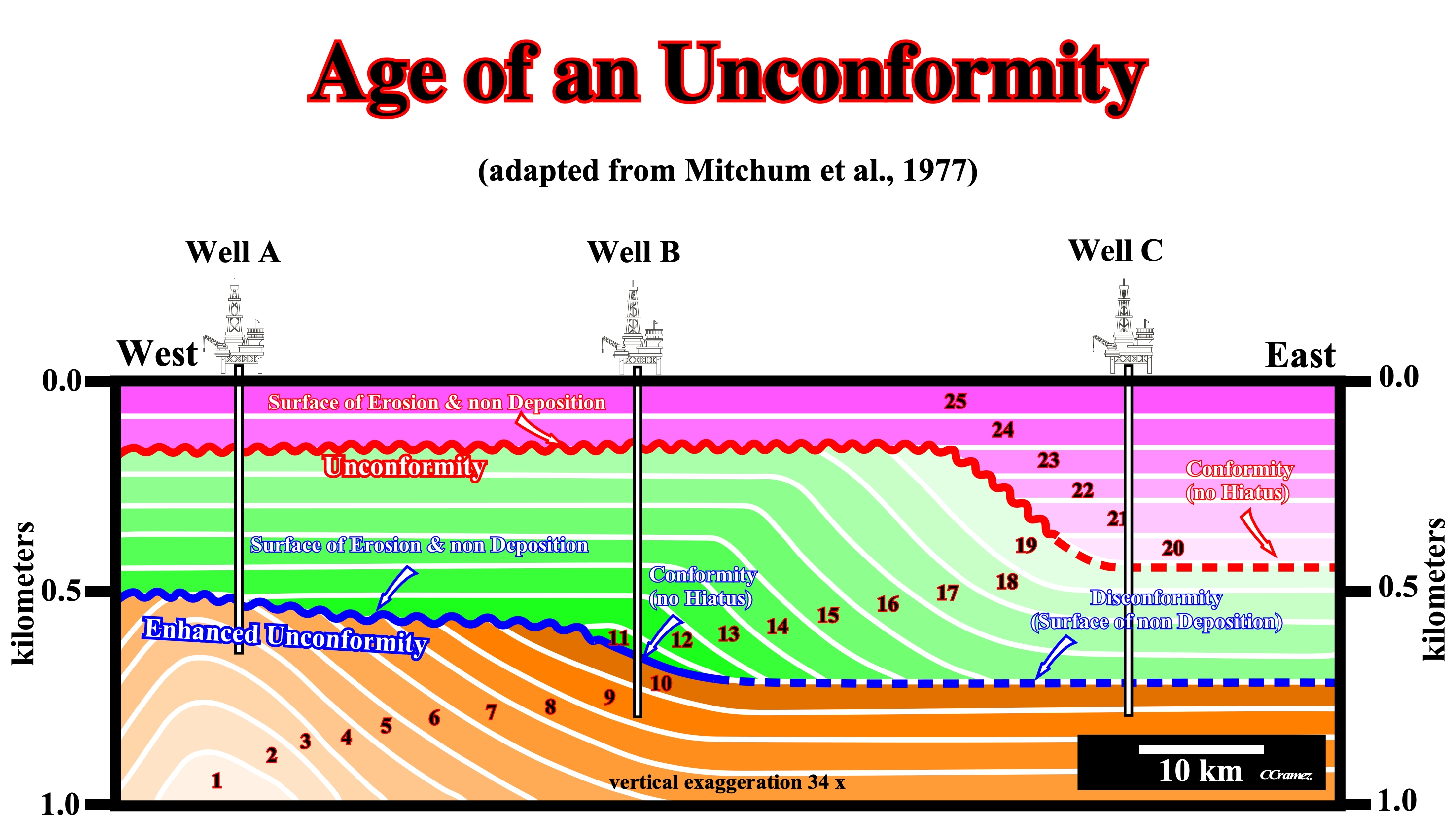

7) Unconformity (Type, Recognition, Age)
In sequential stratigraphy, an unconformity is an erosional surface induced by a significant relative sea level fall. In other branches of the Geology an unconformity can have other meanings.
The origin, meaning and spatial / temporal extension of unconformities are important questions to be asked in all tectonic and stratigraphic studies. The term unconformity, with time and, particularly, after the advent of Sequential Stratigraphy, is, most often, misused.
Goguel (1952) considered, at the structural point of view, it is common to distinguish tabular and folded areas. Such a distinction depends on the age of the observed strata in relation to the age of deformation. The strata postdating deformation lie upon strata predating deformation with an angular unconformity (tectonically enhance unconformity in sequential stratigraphy), between both strata, which recognition is of fundamental importance.
Grabau used the term unconformity to designate a stratigraphic hiatus (gap) corresponding to a transgression. He distinguished two types of unconformities and name them with two different terms : (i) “ Nonconformity ” to denominate an angular unconformity and (ii) “ Disconformity15 ”, to designate an interruption in the sedimentary chronological sequence, in which there is no apparent angular unconformity.
15 For many geoscientists a discontinuity designates a transition or contact between intervals at different densities, such as Mohorovi?i?, discontinuity, or with different sedimentary facies (lithologies), or between intervals separated by a hiatus (absence of significant deposition). In geology there are several types of discontinuities: 1- Stratigraphic ; 2- Sedimentary ; 3-Lithological ; 4 - Tectonics, etc.. Among the lithological discontinuities, which are the most important in sequential stratigraphy, we can recognize: (i) Concordant Discontinuities, when there is continuity between successive intervals ; (ii) Paraconform Discontinuities or Paraconformities, when there is no difference in attitude between overlapping intervals, but there is a hiatus due to the absence of significant deposition between them ; (iii) Nonconform Discontinuities or Nonconformities (which certain authors call Heterolytic Discontinuities), when there is a contact between a sedimentary interval and an older igneous body ; (iv) Discontinuous Discontinuities or Disconformities, when the layers of the intervals are parallel on either side of the contact surface which does not conform to the regional stratification ; (v) Discordant Discontinuities or Unconformities when the two intervals are separated by an erosional surface induced by a relative sea level fall ; (vi) Enhanced Discordant Discontinuities or Tectonically Enhanced Unconformity, when the sediments of the interval underlying an unconformity discordance were deformed by tectonics (shortened or lengthened) ; (vii) Intrusive Discontinuities, when an igneous body traverses a sedimentary series; (viii) Mechanical Discontinuities, when they are induced faulting, etc. (https: // estpal13. wordpress.com/2013/06/04/ descontinuidades-sedimentares-e-estratigraficas/).
A. Orbigny used the terms:
(a) True unconformities for angular unconformities and ;
(b) Unconformities of isolation for a stratigraphic hiatus.These terms have been forgotten.
Bally (1989), on the importance and significance of unconformities in the sequence stratigraphy, reported that unconformities can have very different origin. In certain unconformities, as those mentioned below, the eustatic component seems insignificant, i.e., eustasy seems not to be the major geologic cause of the unconformities :
- The unconformities characterized by erosion and truncation of the tilted fault blocks ;
- The unconformities induced by deepwater currents on the slope ;
- The unconformities associated with canyons on the divergent margins ;
- The unconformities seen in shallow water environments induced by geostrophic currents16;
- The unconformities associated with starved geological conditions ;
- The unconformities underlying the onset of seafloor spreading ;
- The break-up unconformities ;
- The basal foredeep unconformities17 ;
- The unconformities associated with the relaxation of the foredeep basins ;
- The unconformities associated with salt flowage, etc.16Geostrophic currents are atmospheric or oceanic currents in which the force of horizontal pressure is balanced (equal, but opposite) by the Coriolis force. They are not either accelerated or affected by friction.
17Considering the limits of sequences and the origin of unconformities associated with foredeep basins, as for instance in the Neuquén geographic basin, the problem becomes quite complicated. Indeed, beyond the unconformities which may have a very strong eustatic origin, one must consider at least two other major unconformities with the tectonic origin is preponderant : a) The basal unconformity associated with erosion in shallow and induced migration of peripheral bulge of the plunging tectonic plate (subduction type A) ; b) The unconformity, located more downstream, which separates the backarc sediments from the foredeep basin sediments.
These unconformities require an exhaustive characterisation and differentiation, because most them, often, are taken in a very general sense and interpreted just in terms of eustatism, as proposed by P. Vail, based on the assumption that the rate of tectonic events (subsidence, folds, faults movements) is much slower than the rate of eustatic variations of sea level, but neglecting others parameters such as the subsidence induced by the weight of sediment or sudden variations in sediment influx, etc.

Figure 029- As illustrated on this tentative geological interpretation of a Canvas autotrace of a Baltimore Canyon (New Jersey offshore) seismic line, several unconformities were considered. All of them were induced by relative sea level falls that put the sea level below the basin edge (generally, the shelf break, when the basin has a shelf). Certain unconformities, as the pre-rifting unconformity, breakup unconformity (BUU) and the unconformity associated to the top of the seaward dipping reflectors (subaerial lava flows) were, locally, tectonically enhanced, and so, they correspond to seismic surface characterized by typical geometrical relationships. Similarly, the unconformity SB. 96.5 Ma, westward of the Triassic salt dome, was, locally, tectonically enhanced due to the emplacement of a volcanic plug, which presence was corroborated by magnetism and drilling. The others unconformities are cryptic, i.e., there is, locally, they are conform to the underlying and overlying reflectors. A cryptic unconformity can be recognized in particularly places, where the erosion associated with the relative sea level fall is obvious, as, for instance, in incised valley fills and submarine canyon fills and then the3y can be followed, laterally, more or less, in continuity.
In strict sense and particularly in Sequential Stratigraphy, an unconformity is an erosional surface induced by a relative sea level falls, big enough, to put the seal level below the basin the edge, which, in certain geological situations, may correspond to the shelf break and, in others, to the continental break (top of the continental slope), when the basin has not a shelf (lowstand geological conditions). In the broad sense, unconformities are discontinuous stratigraphic surfaces, in which the associated time-gap may represent:
a) Simply prolonged periods of subaerial exposures with minimal erosion(local valley or channel downcutting) ;
b) Periods of uplift and major subaerial erosion of strata ;
c) Submarine erosion18 by turbidite, slump or submarine currents.18Submarine erosion induced by gravity or turbiditic currents is generally relatively local. The associated unconformities with such an erosion are, mainly, located in deep water environments (slope and abyssal plain). These unconformities do not have equivalent in shallow water environments. Consequently, they are not boundaries stratigraphic cycles boundaries but when the sequence-cycles are incomplete, i.e., only composed by deep water strata.
Unconformities being induced by relative sea level fall, i.e., by a relative uplift and erosion are characterized by:
(i) Truncation, below the unconformity ;
(ii) Onlapping , below the unconformity.Similarly, the unconformities emphasized by incised valley fills or submarine canyons fills are, obviously, characterized by:
(i) Onlaps, above the unconformity ;
(ii) Truncation (erosional toplaps) below the unconformity.

Figure 030- In this figure are depicted unconformities Type I and Type II considered, initially, by P. Vail. Presently, almost all Type II unconformities, considered by Exxon’s geoscientists, are considered as Type I. The concept of Type II unconformity seems to have disappeared from the scientific literature. The Type I unconformities are the boundaries of the stratigraphic cycles and their age is the age of the associated relative sea level fall (see figure 031), which can be given by the age of the basin floor fan of the overlying sequence-cycle. Thus, only an exploration well crossing the basin floor fan, induced by a given relative sea level fall, allows a correct dating of the associated unconformity. In this figure, the paleontological results of the wells A and B do not allow to date the basal unconformity of middle sequence-cycle (complete sequence-cycle). Just the paleontological results of the exploration well C can date the basal unconformity, because it drilled the associated basin floor fan. Indeed, when a core drilling is perform in a submarine basin floor fan, a geoscientist has the possibility to date it, if the pelagic layer of the Bouma sequence is recognized. Just, such a stratigraphic level contain the fauna contemporaneous of the relative sea level fall. In all others layers of the Bouma’s sequence the fauna is transported.
Very often, geoscientists confound valley with valley fill and channel with channel fill:
- A valley is a morphologic feature which characterized by low-lying land bordered by higher ground ;
- A valley fill or valley infilling is the name given to the, more or less, unconsolidated sediment deposited, by any agent, that totally or partially fill a valley ;
- A channel is the bed where a natural body of water flows or may flow ;
- A channel fill or channel infilling names the sediments deposited in a stream channel, especially, in an abandoned cutoff channel or where the transporting capacity of the stream is insufficient to remove material supplied to it.
For P. Vail, in the framework of sequence stratigraphy, all unconformities are related to erosion induced by absolute or relative changes in the level of the sea, what is quite different of the previous hypotheses advancing by E. Beaumont, E. Argand, Wegmann and other, for whom the principal origin of the erosional surfaces is related to transgressions (relative sea level rises). The Vail's unconformities (cryptic unconformities) can be, locally, enhanced by tectonics (“tectonically enhanced unconformity”).
In fact, the concept of tectonically enhanced unconformity (“angular unconformity”) implies, a prior, the concomitant development of regional and local structures. Unconformities can be very sensitive time markers which record the evolution of structural deformations. This is particularly true in perisutural sedimentary basins related with the formation of megasutures, which, unfortunately, is often forgotten by many geoscientists. The recognition of abrupt tectonic transitions allow the geoscientists to apprehend the progression of the structural continue deformations and so to define the age of the structural traps, which have more chances of trap hydrocarbons, when the age of hydrocarbon migration is known.
Taking an attentive look at the next geological sketch (figure 031), you can, easily, understand how the age of an unconformity can be determined, particularly when it is locally tectonically enhanced.

Figure 031- As said previously the age of an unconformity is the age of the relative sea level fall that induced it. In this geological sketch, the well A can never give the age of the unconformities that it recognized. The micropaleontological results of the well A can just indicate that the upper unconformity, which is not tectonically enhanced, is younger that the time interval 17 and older that the time interval 24, and that the lower unconformity is younger that the time interval 5 and older than the time interval 12. In fact, the well crossed both unconformities in the sector where they correspond to surface with a depositional high. The well B cannot either date the upper unconformity (the red one), but can easily date the lower one (in blue), since it crossed the segment of the unconformity where there is conformity, between the underlying and overlying intervals, that is to say where there is no hiatus. The micropaleontological results of the well C, can date the upper unconformity, since it crosses the unconformity in a sector where there is conformity between the overlying and underlying intervals and no hiatus, but cannot date the lower unconformity, because it crosses it in the distal sector where there is a disconformity with a large depositional hiatus. Note that downlapping can characterize a sequence boundary but not an unconformity (erosional surface).
The hypothesis of tectonically enhanced unconformities can be tested very easily. Geoscientists need just a good stratigraphic and biostratigraphic analysis of observed data to see if subsidence and / or the tectonic regime continue after the unconformity